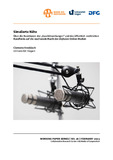Citation link:
http://dx.doi.org/10.25819/ubsi/10263Files in This Item:
| File | Description | Size | Format | |
|---|---|---|---|---|
| Knobloch_Simulierte_Naehe.pdf | 330.42 kB | Adobe PDF |  View/Open |
| Dokument Type: | Book | metadata.dc.title: | Simulierte Nähe | Title addition: | über die Reaktionen der „Qualitätszeitungen“ und des öffentlich-rechtlichen Rundfunks auf die wachsende Macht der digitalen Online-Medien | Other Titles: | Simulated proximity : on the reactions of the "quality newspapers" and public service broadcasting to the growing power of digital online media | Authors: | Knobloch, Clemens | Institute: | Fakultät I Philosophische Fakultät | Free keywords: | Nähe, Distanz, Qualitätsmedien, ARD, Moralisierung, Kontaminationsbegriff | Dewey Decimal Classification: | 302.23 Medien (Kommunikationsmittel), Medienwissenschaft | GHBS-Clases: | KNZH ALWO |
Issue Date: | 2023 | Publish Date: | 2023 | Series/Report no.: | Working paper series / SFB 1187 Medien der Kooperation | Abstract: | Ausgehend von einem Gutachten, das die Kognitionswissenschaftlerin Elisabeth Wehling im Auftrag der ARD 2019 erstellt hat, und das den Anstalten der ARD empfiehlt, ihr angeschlagenes öffentliches Image dadurch zu verbessern, dass sie in allen Verlautbarungen ihre moralische Gemeinschaft mit dem Publikum rhetorisch herausstellen, geht der Text der These nach, dass der öffentlich-rechtliche Rundfunk und die sogenannten Qualitätsmedien sich ohnehin per simulierter Nähe den Kommunikationsbedingungen der Digitalmedien und sozialen Netzwerke anpassen. Diesen letzteren gegenüber versuchen sie aber, ein Tatsachenmonopol für sich zu errichten. The point of departure for this paper is a report commissioned by the German Public Radio and Television Board ARD in 2019 with the goal of devising a strategy to improve its public image, which had been greatly damaged by a series of financial scandals. Produced by the cognitive scientist Elisabeth Wehling, the report made the recommendation that the ARD should aim in its messaging and rhetoric to cultivate the sense that the broadcaster and its audience constitute a common moral community. This paper argues that the traditional media – represented primarily by public broadcasters and broadsheet newspapers – have in fact been following this strategy of "simulated intimacy" all along in order to adapt themselves to the conditions of communication created by new digital media, in particular social networks. However, in order set up a contrast between themselves and the social media platforms, traditional media seek to emphasize their monopoly on objective, factual reporting. |
DOI: | http://dx.doi.org/10.25819/ubsi/10263 | URN: | urn:nbn:de:hbz:467-24562 | URI: | https://dspace.ub.uni-siegen.de/handle/ubsi/2456 | License: | http://creativecommons.org/licenses/by-nc-nd/4.0/ |
| Appears in Collections: | Publikationen aus der Universität Siegen |
This item is protected by original copyright |
Page view(s)
576
checked on Jan 18, 2025
Download(s)
255
checked on Jan 18, 2025
Google ScholarTM
Check
Altmetric
This item is licensed under a Creative Commons License


